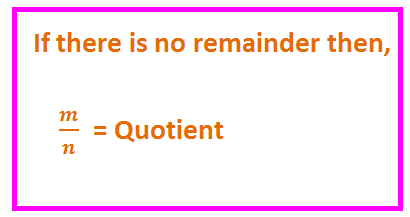Integer Review: Fundamentals of Integers , Rules for Multiplication , Rules for divisibility, Division Terminology, Even & Odd Integer, Rules about even & odd integer, Prime Number, Prime Factorization , Distinct Prime Number, LCM & HCF, Composite Numbers , Consecutive Integers
Class Questions : Exercise 1 Exercise 2 Exercise 3 Exercise 4 Exercise 5
Practice Questions : Solutions
_________________________________________________________________________
Q.11 The quotient of m/7 is an odd integer and there is no remainder. Which must be the correct statement from below?
A . ‘m’ is a prime integer
B. ‘m’ is a consecutive integer
C. ‘m’ is an even integer
D. ‘m’ is an odd integer
E. ‘m’ is multiple of 3
Solution
The odd integers are 1, 3, 5, 7…………………. Here it is given that the quotient of m/7 is an odd integer that means the quotient will be 1, 3, 5, 7 ……………….
We can refer Division Terminology in the Review Section of Integer
If m/7 = 1; then m = 7
m/7 = 3; then m = 21
m/7 = 5; then m= 35
That means for any value of m/7 to be odd the value of ‘m’ must be odd. So the correct answer choice is ‘D’.
Q.12 What are the multiples of 3, 6, & 9 all together? Choose all the options from the following.
A. 12
B. 15
C. 18
D. 45
E. 54
Solution;
If we check option choice one by one we can easily get the answer.
Multiples of 3 = 3, 6, 9, 12, 15, 18…………………
Multiples of 6 = 6, 12, 18, 24……………….
Multiples of 9 = 9, 18, 27 ,36, 45, 54………………
12 is a multiple of 3 and 6 but not of 9
15 is a multiple of 3 but not of 6 and 9
18 is a multiple of 3, 6 and 9
45 is multiple of 3 and 9 but not 6
54 is a multiple of 3, 6 and 9
So, correct answer will be C and E.
Q.13 m is an even integer and n is an odd integer
Quantity A Quantity B
3 m/n
A. If Quantity A is greater
B. If Quantity B is greater
C. If Quantity A and Quantity B are equal
D. The relationship cannot be determined from given information
Solution;
Let us take values for m and n
If m = 2, n = 1 then m/n = 2/1 = 2 Quantity A is greater
If m = 12, n =3 then m/n = 12/3 = 4 Quantity B is greater
So, Both the Quantity A & Quantity B cannot be compared from given data, Hence
Answer is ‘D’.
Q.14 Dividend ‘x’ = 36. ‘x’ is square of its quotient
Quantity A Quantity B
Divisor of ‘x’ 6
A. If Quantity A is greater
B. If Quantity B is greater
C. If Quantity A and Quantity B are equal
D. The relationship cannot be determined from given information
Solution;
Here it is given that Dividend = x = 36, which is square of its quotient. That means 36 is square of its quotient which should be ‘6’. So if we divide 36 with 6 then only ‘x’ can be square of quotient.
So in above condition;
Dividend = x = 36
Divisor = 6
Quotient = 6
The value for Quantity A will be 6. Now if we compare The value of Quantity B which is also 6 , it comes out equal so correct answer choice will be ‘C’.
Q.15
The integer m is even and integer n is even and prime. The square of ‘m’ is addition of m and n. Find the least possible value for ‘m’?
Solution;
The possible values for ‘m’ could be 2, 4, 6, 8………………………..
The value for ‘n’ will be = 2, as 2 is only even and prime number.
Now if we take ‘m’ = 2, ‘n’ = 2, then m2 = m x m = 2 x 2 = 4
Now addition of m + n = 2 + 2 = 4.
As the least possible value is being asked, so this condition justifies the asked question.
So the least possible value for ‘m’ will be =2.

